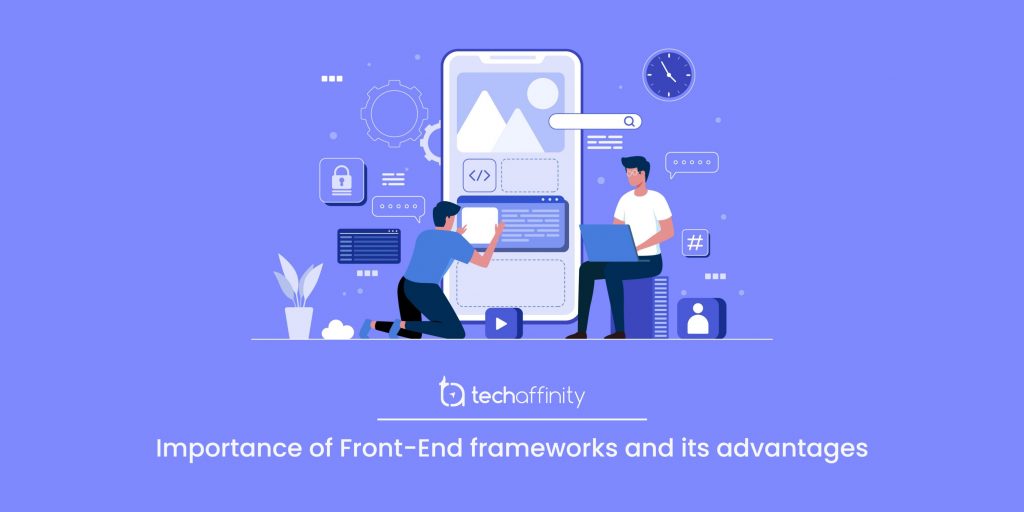Importance of Front end Frameworks and its Advantages

Author : Amarnath S 23rd Feb 2023

Front-end development is vital in a web application’s performance as this integrates two crucial areas, the website front end UI design (vision, look and feel of the web application) and the back-end development (The business logics of the entire system).
In recent days, the end-users of the web based system are at a greater focus, hence it is vital to provide a seamless UI experience to retain the customers in the long run to make the client’s business successful. The first and foremost focus in this entire process is developing a user interface that is intuitive and crystal clear.
Most technology geeks are predominantly using frontend frameworks. As the name suggests, frontend refers to how a web application should appear to a user in terms of look and performance. The place holder’s arrangement for the content positioning, UI graphics, etc., will contribute to the visual feel of the system. Hence, the frontend framework can be defined as a vital tool used for the visual aspect and performance for a web based application. Some of the prime tasks associated with this front end frameworks include managing the AJAX requests which the data on display can dynamically update without refreshing the entire page by sending the request to the server to update each and every page. Instead, the particular data of a component will update without disturbing the entire page, reducing the requests to the server and the performance of the system will be comparatively good. Other tasks include correlation of the data with the document object model, outlining of the file structures, styling and designing of the web application components.
The front-end of a Web application is the page/component which will be rendered by the browser to the user. The graphics and its typography, the size, form, structure, weight, texture, colour, and direction, and the arrangement of the graphic and the typography contributes to the user interface. In addition to this, it also includes building user-friendly interfaces by effectively rendering the data from the back end database to a user viewing in the browser. The type of the web application to be developed, adaptability and cost-effectiveness are the main factors to be considered before choosing a front end framework for the web application development.
Hence the front-end framework is a platform to build the front end of the website/web application. The trending frontend technology stacks are Angular, Vue, JS, and React. The JS ecosystem is mainly used for large scale systems. JavaScript and JQuery are suited for building small-scale applications with a robust and clean User Interface.

React – React was initially developed by the coders from Facebook’s team. Facebook was an emerging application and required continuous scalability and needed enhancements and improvements, which was a challenge for them in managing the code. React gave the provision to make frequent updates to the code more easily and effectively. The unique feature about the React is its Virtual Document Object Model (DOM) with significant functions. The core advantages of React is it is easy to learn and use, reusability and collaboration, affordability of virtual DOM which allows a seamless performance and fast rendering of data. Significant progress in the productivity and maintenance, the updates and the enhancements can be made in the application easily. ReactJS is used for developing the UI part of the application with more efficiency. React is predominantly used for developing single-page applications. It is one of the highly preferred frameworks used for User Interface development. Reusability is one of its salient features when developing the application with an interactive interface in a limited time due to the reuse of the components in this framework.
Angular is an application-design framework and development platform for developing promising and sophisticated single-page apps which is based on Typescript. Mobile and web applications can be built using Angular. In addition to the single page applications, multi-page web applications can also be developed using Angular. Similar to ReactJS, it is an open-source platform used to create the user interfaces on the front end. The major difference between React and Angular is Angular’s two-way binding feature which allows the association of any changes made in the model with the view. Real-time model-view synchronization makes it simple to accommodate any enhancements to the application.
VueJS is a versatile, simple and straightforward framework. It is an open-source model–view frontend JavaScript framework for developing the user interfaces and single-page applications. It is comparatively smaller in size and like Angular, Vue offers two-way binding feature, Visual Document Object Model and component-based programming. This framework is suitable for developing dynamic and small scale web applications.
Final Thoughts
We at TechAffinity, have experts who are well versed and have been working with the Front end Frameworks. In the past, our team has successfully implemented the projects with these Front end Frameworks and backend end technologies for complex applications i.e., an API driven approach for our client’s projects which worked seamlessly. You can shoot your queries to media@techaffinity.com and our team will get in touch with you.
